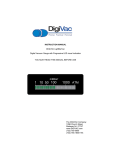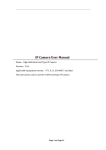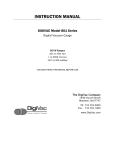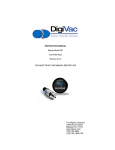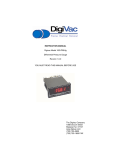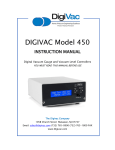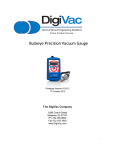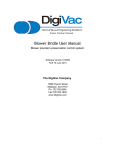Download DigiVac 200 Pirani Instruction manual
Transcript
INSTRUCTION MANUAL DIGIVAC Model 200 Pirani Digital Vacuum Gauge Revsion K13A YOU MUST READ THIS MANUAL BEFORE USE Readings from 1 – 2000 millitorr The DIGIVAC Company 105B Church Street Matawan NJ 07747 www.DIGIVAC.com (732) 765-0900 (732) 765-1800 FAX CONTENTS 1.0 Description and Principle of Operation. 2.0 Construction. 3.0 Unpacking and Inspection. 4.0 Installation. 5.0 Operation. 6.0 Servicing and Calibration. 7.0 Notes on Calibration. 8.0 Understanding Microns, Torr, and Absolute Pressure. 9.0 Accessories and Modifications 10.0 Terms & Conditions Instruct/200 Pirani.4vlc DIGIVAC 201 series Instruction Manual Page 2 1.0 DESCRIPTION AND PRINCIPLE OF OPERATION. The Model 200 Pirani is a full featured vacuum instrument that is fast, accurate and rugged. This unit builds on the engineering philosophy that made the Model 200 our best selling vacuum instrument: simple is best and robust is a must. The model 200 Pirani employs a VRC Pirani tube instead of a Varian 531 gauge tube. The instrument features large, bright LEDs visible from across the room with a hard, vinyl clad metal enclosure. This entry into our gauge line-up, enables the user to choose yet another sensor option to best meet their vacuum requirements. The straight forward design yields a low power instrument, that is simple to build and simple to operate. The low power feature reduces thermal effects, to improve repeatability. Unlike many other Pirani gauges on the market, this unit has been recently redesigned with newer, more reliable components to insure a long product life. The Model 200 Pirani can be ordered with optional control relays, analog output, and RS232 output, to simplify integration with existing process controllers or computers. In addition, this device can be Ethernet enabled, to allow monitoring via a web browser with our free ReAct browser software. Get access to your instrument from across the hall, or across the world. All instruments leave our factory tested and calibrated under real vacuum against a NIST standard. 2.0 CONSTRUCTION. The controller consists of the indicating and controlling instrument, the sensor configured, the sensor cable, the output interfaces and an international AC power adapter. The instrument is housed in a rugged free-standing vinyl clad metal enclosure. It can be placed on a suitable surface for easy viewing from across the room. The gauge tube houses the various Pirani sensing, heating and compensating elements and terminates in an octal connector. On this model, the connector wiring terminates at the instrument with a 9 pin DSub connection. Regulating circuitry in the DIGIVAC provides constant current for gauge tube excitation, and thus compensates for resistance in the probe leads. 3.0 UNPACKING AND INSPECTION. After the instrument is received, it should be carefully unpacked and inspected for damage during shipment and for completeness. The package should contain, as a minimum, the instrument, the sensor and cable ordered, an AC power adapter and an instruction manual. In the event of a loss during shipment, a claim should immediately be made to the common carrier or the postal service, as applicable. The DIGIVAC warranty pertains only to the instrument, and does not cover losses in shipping. Each 200 Pirani should come with: o User Manual (this document) o Display controller (gray box with red lens) o Power supply (international adapter with US plug) o Configured Sensors o RS232 (optional) o RS232 Port o 5’ RS232 Cable (phono to Female DB9) o Ethernet (optional, includes RS232) o Ethernet Port o Null modem RS232 converter o 2’ Ethernet Cable o Null Modem Ethernet Cable o Configuration CD 4.0 INSTALLATION. The instrument should be located in a clean, dry environment for best results. The gauge tube cable should be identified by wire tags or markings specific to your environment. DIGIVAC 201 series Instruction Manual Page 3 Pirani gauge tubes must be installed in a thread-down orientation in a clean, dry vacuum system. While threading the gauge tube in to the manifold, the gauge tube cable should be disconnected to avoid damage. In this way, twisting of the cable and the octal socket on the tube is avoided. Care should be exercised to install the tubes in a dry part of the system. Since the instrument works on the principle of temperature rise, the probes will not work if they become filled with a liquid such as vacuum or diffusion pump oil. The gauge tube should be protected against oil and other contaminants by installing it in such a way to protect it. A good practice is to mount the gauge tube in the most vertically distant place from oil and other contaminants as applicable. The gauge tube should be mounted in the most stable pressure region of the vessel to be measured. For example, it would be better to install the gauge tube on a tank rather than on the pipe that is directly connected to a vacuum pump. In the event of contamination, see section 6.0 for gauge tube cleaning instructions. The RS232 connection can be made to a PLC or computer via a male DB9 cable connection to the female jack on the DIGIVAC. The DIGIVAC acts as a DCE, so a straight serial connection is appropriate. Please use the supplied 5V AC adapter with your Instrument. This adapter provides clean short protected power to protect and insure accuracy of the internal circuitry. 5.0 OPERATION. After installation, the DIGIVAC is ready for immediate operation. The unit will normally provide accurate readings immediately; when used with a Pirani gauge however, occasionally a gauge tube will have absorbed material during storage and may require as much as 24 hours of operation before accurate readings are attained. It is recommended that the DIGIVAC be energized continuously during vacuum system operation. In this way, the hot filament will not allow contaminants to condense. Only connect and disconnect cables with the power to the unit unplugged. Make all connections to sensors, and relay outputs with the power disconnected. NEVER DISCONNECT SENSOR OR OUTPUT WIRES WHILE UNIT IS POWERED UP. In cases where the system has contaminants, as is often the case with metalizing and coating equipment, it is often effective to isolate the gauge tube with a solenoid or manual valve during periods when contamination is most active. The Instrument has additional outputs which can be used: RS232 – The instrument puts out a standard RS232 serial stream with settings 9600, 8, N, and 1. The unit transmits but does not receive, and displays the current vacuum indication in the current units. Analog out – This output reads from 0 to 5 Volts from a pressure of 1 micron all the way up to 5 Torr. There is a graduation of 1 milliVolt per millitorr. Therefore, 10 milliVolts = 10 millitorr and 4 Volts = 4 Torr. DIGIVAC 201 series Instruction Manual Page 4 If you purchased the Ethernet option, please refer to the model 200 Ethernet Addendum for initial setup. Your 200 Pirani should be set by default with the IP address 192.168.0.200. Surf over to http://192.168.0.200 (or whatever your IP address was set to) and say “yes” to security screens authorizing a DIGIVAC applet to run in your browser. You should see a screen that looks like: Feel free to connect to the IP address:10001 with HyperTerminal, putty or your favorite communication tool to communicate directly with the device. To use the 200 Pirani web terminal capability, highlight Display ►Terminal DIGIVAC 201 series Instruction Manual Page 5 And then you should see a terminal window popup that you can execute all the commands in: Press carriage return or enter to submit the query or change the set point. Note that while the web terminal is open, the main 200 Pirani screen will not update. If at any time the web terminal or the main 200 Pirani applet window becomes unresponsive, close the browser (not just reloading the tab or closing the tab) and reconnect. DIGIVAC 201 series Instruction Manual Page 6 6.0 SERVICING - GAUGE TUBE CLEANING. In many cases, a gauge tube may become fouled with oil or other foreign matter. It is often possible to restore the functionality of contaminated probes with cleaning. If the contaminant is known, the tube should be filled with a fluid that is known to be a solvent to that contaminant. As an example, ether is often effective in removing residues of some oils. Commercial carburetor cleaners are very powerful solvents and are highly effective against some contaminants. After cleaning with solvents, the gauge tube should be completely dried or flushed with a volatile solvent to assure that it is dry prior to re-installing it. If this is not done, contamination of the system may result. 6.1 FACTORY REPAIR AND CALIBRATION. The vacuum gauge assembly is designed to provide years of trouble-free service, and the liberal internal use of plug-in components make it easily repairable. No field servicing of the unit is recommended, other than replacement of the gauge tube, but factory servicing and calibration are available at a nominal cost and turn-around times of 24 hours are typical. 6.2 FIELD CALIBRATION. Each DIGIVAC vacuum gauge controller is calibrated to the particular vacuum gauge sensor that is shipped with the unit. While changing the gauge tube is possible, it will result in a slightly different reading as all gauge tubes are not created equal. Calibration for this unit must be performed by DigiVac. Before re-calibrating the instrument, it should be ascertained that the instrument is in fact incorrect. In many cases, the problem will be with a tube that is fouled, or a system that is operating improperly. It is recommended that a spare tube be kept on hand and stored in a clean, dry place. Then, in cases of suspect readings, the tube should be changed before proceeding further. 7.0 NOTES ON CALIBRATION. The DIGIVAC is calibrated in nitrogen, which has thermal properties virtually identical to air. If you are using a Pirani vacuum gauge, other gases will affect the readings by an amount proportional to the thermal conductivity of the gases. In most cases, the gases present in a vacuum system will be air, nitrogen, or oxygen, and no appreciable errors will occur. Certain other gases, however, have thermal conductivity significantly greater than air and will cause the instrument to read higher than the actual amount of pressure. Examples of such gases are water vapor, fluorocarbon refrigerants, and acetone. Conversely, other gases have thermal conductivity significantly lower than air and will cause the instrument to read lower than actual pressure. Examples of such gases include helium, oxygen and to a lesser extent, CO2. When interpreting readings using gases other than air, it should be borne in mind that the DIGIVAC reads Millitorr, which is a measure of absolute pressure - that is the opposite of vacuum. Thus, a lower numerical reading actually is a higher level of vacuum. For more information, refer to section 8.0. Note that isolated transducers like capacitance manometers are independent of gas type. 8.0 UNDERSTANDING TORR. The DIGIVAC and many similar instruments are calibrated in microns or "millitorr." It is appropriate to discuss what microns are and to relate microns to other measures of pressure and vacuum. DIGIVAC 201 series Instruction Manual Page 7 Microns are not really a measure of vacuum at all, but rather of absolute pressure. It will be recalled that the pressure of the atmosphere is 14.696 or approximately 14.7 pounds per square inch at sea level. This pressure is due to the weight of all of the air in the earth's atmosphere above any particular square inch. This 14.696 psi is equivalent to the pressure produced by a mercury column of approximately 29.92 inches high or .76 meters (about 3/4 of a yard) or 760 millimeters of mercury. Atmospheric pressure varies greatly with altitude. It decreases approximately 1 inch of mercury per thousand feet of altitude. It also varies widely with local weather conditions. (Variations of one half inch in a single day are common.) The word vacuum means pressure lower than atmospheric or "suction," but, in describing negative pressure, the atmosphere is only a satisfactory reference if we are dealing with values of vacuum down to about 27 inches of mercury. Below that, it is much more useful to talk in terms of absolute pressure, starting from absolute zero. The DIGIVAC and all similar instruments do just this. One TORR, a commonly used unit, is an absolute pressure of one millimeter of mercury. A millitorr is equal to one thousandth of a TORR. A MICRON is the same as a millitorr. The full scale reading of a DIGIVAC is 1999 microns and is equivalent to 1.999 TORR of approximately 2/760 of atmospheric pressure. This is less than .1 inches of mercury, and less than .05 PSI. DIGIVAC 201 series Instruction Manual Page 8 9.0 ACCESSORIES AND MODIFICATIONS. The following are offered as accessory equipment or field-installed modifications. Padded shoulder strap Case with Velcro closure- For instruments that will be used in the field, particularly in cryogenic applications, a padded shoulder strap case is available. COMPATIBILITY WITH OTHER GAUGE TUBES. On special order, DIGIVAC Instruments can be provided to use with most other vacuum gauge tubes. AC and DC excitation are available. Gauges have been provided for Hastings, Varian, Thermionics, Veeco, VRC, and Fredericks gauge tubes. DIGIVAC 201 series Instruction Manual Page 9 10.0 TERMS AND CONDITIONS . TERMS OF USE, LIMITED WARRANTY & LIABILITY WAIVER THE DIGIVAC COMPANY (“DIGIVAC”) offers all of its products with the following terms and conditions and notices as follows. By accepting and/or using a DIGIVAC product, you hereby acknowledge and agree to the following terms and conditions, and acceptance of these terms and conditions are a condition precedent to any purchase/sale agreement between you and DIGIVAC. EXCLUSIVE OBLIGATION: The DIGIVAC product you are purchasing has been designed for a specific use within a set of suitable operating conditions, as set forth in its User Manual, or as indicated otherwise by DIGIVAC. Any use of the DIGIVAC Product for any purpose or under any conditions, other than those specified, shall render any limited warranty void, and shall expressly invalidate any liability of DIGIVAC for damages as a result of such misuse. USER LIMITATION: You may not modify, copy, distribute, transmit, display, perform, reproduce, publish, license, create derivative works from, transfer, or sell, any information, software, products or services obtained from or created by DIGIVAC to any third party, without the express written consent of DIGIVAC to do otherwise. Any violation of this provision shall give rise to an indemnification of DIGIVAC by you, for any third party claims arising out of such violation. THIRTY (30) DAY LIMITED WARRANTY: All DIGIVAC products are warranted against any manufactured defect for a period of thirty (30) days from date of purchase, unless such product is a custom-work for you and not a standard DIGIVAC product. Any product qualifying as a custom-work shall not be warranted against any defects for any purpose, and your acceptance of such custom-work shall relieve DIGIVAC of any liability for any purpose. WITH THE EXCEPTION OF THE LIMITED WARRRANTY ABOVE, YOU AGREE ANY DIGIVAC PRODUCT IS PROVIDED AS IS, EXCLUSIVE OF ANY WARRANTY, INCLUDING, WITHOUT LIMITATION, ANY IMPLIED WARRANTY OF MERCHANTABILITY, FITNESS FOR A PARTICULAR PURPOSE, NON-INFRINGEMENT, OR ANY OTHER WARRANTY, EXPRESSED OR IMPLIED. LIMITATION OF LIABILITY: You agree and acknowledge, DIGIVAC shall have no liability to you whatsoever for any direct, indirect, punitive, incidental, special consequential damages arising out of or connected with the use or misuse of its products. In particular, given the nature of DIGIVAC products, you agree and acknowledge, under no circumstances whatsoever shall DIGIVAC be liable to you for any consequential damages for damage to any non-DIGIVAC product or service, arising from the failure, use or misuse of a DIGIVAC product, including, but not limited to, any vacuum system, engine, vehicle, factory, or the like. In the event, a court of law with proper jurisdiction finds DIGIVAC liable to you for any purpose, you agree and acknowledge DIGIVAC’s maximum liability shall not exceed the purchase price of one unit of product giving rise to such liability, or $250.00, whichever is greater. ENTIRE OBLIGATION: These terms and conditions express the entire obligation of DIGIVAC with respect to its products. If any part of these terms and conditions are deemed void, invalid, unenforceable or illegal, including, but not limited to, the warranty disclaimers, liability disclaimers and liability limitations set forth above, then the unenforceable clause or sentence may be disregarded with the remainder of these terms and conditions valid and enforced. In the event the unenforceable clause or sentence leaves a void in these terms and conditions, a provision closely matching the intent of the unenforceable provision should be deemed inherent within these terms and conditions, slightly modified to render such provision valid and enforceable. GENERAL: These terms and conditions are governed by the laws of the State of New Jersey, USA. You hereby consent to the exclusive jurisdiction and venue of the Courts of New Jersey, in all disputes arising out of or relating to the use of this product. Use of this product is unauthorized in any jurisdiction that does not give effect to all provisions of these terms and conditions. MODIFICATION OF TERMS AND CONDITIONS: DIGIVAC reserves the right to change the terms, conditions, and notices under which their products are offered. DIGIVAC 201 series Instruction Manual Page 10











